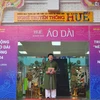 Colorful to he products made from glutinous rice powder are always attractive to children. (Photo: Vietnamplus)
Colorful to he products made from glutinous rice powder are always attractive to children. (Photo: Vietnamplus)
Hanoi (VNA) – The to he (toy figurine) is a kind of folk toy of Vietnamese children and edible. Today, making to he is a folk culture in Vietnam, especially in the North.
Traditional to he
Originally, the to he, made from glutinous rice powder, was used for worshiping so they often took the shape of animals such as peacock, chicken, buffalo, cow, pig, and fish. The product was called a ‘chim co’ (animal) toy. In some areas in the North, it was called ‘cake’ because it was created in the shape of a bunch of bananas, arecas, and some popular dishes to form an offering tray to the pagoda along with the shape in popular animals.
With colours similar to the real products, to he toys were added sugar so they can be eaten. Later, to he was attached to a trumpet with malt on its tip. When blowing, it produced a soft noise which sounds ‘to he’.
According to craftsmen from Xuan La village, Phuong Duc commune, Hanoi’s Phu Xuyen district, farmers in their free time ground rice into fine powder, steamed it and then used different kinds of vegetables and ash to colour the rice powder with basic colours - green, sea blue, red, purple, yellow, white and black. After that, they shape the dough into edible figurines such as trees, animals, flowers or characters from folk stories. Children can even eat to he after playing with them.
To he craftsmen often leave their home to rural markets, villages and streets, especially at festivals, to make To he for sales. They carry a compact set of tools, and in one day they can make stops at several markets, communal temple grounds and especially local festivals where children often gather to play or accompany their parents. Many children and adults are delighted to see the beautiful toys created by skillful and creative artisans with simple tools, including a knife, a small comb, a bunch of bamboo sticks and a box to display their products.
The two most important occasions each year for to he craftsmen are Tet (lunar New Year) and the Mid-Autumn Festival because they are the favourite holidays among Vietnamese children.
Traditional toy hobby restoration
According to cultural researcher Trinh Bach, before the 1960s, every Mid-Autum Festival, animals made of powder were sold everywhere in Hanoi and northern provinces, as an indispensable component for a Mid-Autum offering tray.
The toys were attractive to both children and adults.
Later, some people from the North who migrated to the South brought along with the tradition and it remained there until the late 1980s.
Craftsman Dang Van Hau said that there are three kinds of the figurine toys he has restored in recent times. The Dong Xuan Mid-Autume toys are domestic animals like buffalo, horse, goat, dog, chicken and pig called the set of flocks and herds. Besides, there are animals familiar to the daily life such as crab, fish or daily things.
Another kind is animals of Pho Khach (Chinese resided streets in the past) that were around the Hanoi ancient quarter, like icons or animals in legend stories.
The last is animals of Phu Xuyen, normal called ‘chim co’ (animal) cake. It is diverse and created by local craftsmen.
Of the three kinds of to he toys, the first and the Dong Xuan Mid-Autum and Pho Khach toys were almost lost in the early 1990s and no body made them.
Today, artisans not only make to he with the simple shapes of popular animals and fruits, but also form many other diverse shapes such as animals in the 12 Chinese zodiac, favourite characters of children like Aladin, Doraemon, Pokémon, Ton Ngo Khong (the monkey king) and Na Tra./.
























